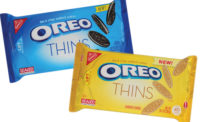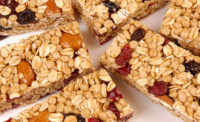State of the Industry 2016: Bars continue to address diverse lifestyle needs
Healthier ingredients and untapped markets define the snack and nutritional bar category.

courtesy of General Mills Inc.

courtesy of Kind LLC

courtesy of Clif Bar & Company

courtesy of PepsiCo

courtesy of Think Thin LLC

courtesy of Bosch Packaging Technology Inc

courtesy of Think Thin LLC

Bar Sales

Bar Sales

Bar Sales

Bar Sales











The bars category continues show good to strong levels of growth, with sufficiently diversified product offerings to appeal to nearly every type of shopper. Few product categories so seamlessly fit into today’s on-the-go lifestyle suited to on-demand snacking.
Overview | Bread | Tortillas | Sweet Goods | Snack Cakes | Pizza | Desserts | Cookies | Buns & Rolls | Bars | Breakfast Products
“The market is growing because bars fit perfectly into our lifestyle,” says Dave Caucutt, vice president of sales and technical services, Lawrence Foods Inc., Elk Grove Village, IL. “We are a mobile society eating many of our meals on the run. Millennials have propelled us all to change to become a snacking culture. And bars carry a healthy halo because they are often fortified to provide a balanced meal alternative.”
Market data
It’s not surprising that bars, appealing to consumers seeking on-the-go snacking, meal replacement options and nutrition, are going strong. According to IRI, Chicago, sales of snack and granola bars grew 4.78 percent in dollar sales for the 52 weeks ending April 17, 2016, reaching $5.9 billion.
The “all other” snack/granola bar segment—representing products that don’t easily fit into the breakfast/cereal/snack, granola and nutritional/intrinsic value segments—saw the strongest growth, up 101.38 percent in dollar sales for the year. General Mills posted the most-notable gains, up 347.97 percent in dollar sales. The company also saw a 14.83 percent dollar sales gain for its breakfast/cereal/snack bars. General Mills offers multiple brands of bars, includingNature Valley, Lärabar, Fiber One, Annie’s, Cascadian Farm and Epic, with the latter bringing meat-focused products into the mix.
Nature Valley saw growth of 177.64 percent in all other snack/granola bars and 9.71 percent for its Sweet & Salty granola bars line. But the real standout for the brand was in the breakfast/cereal/snack bars segment, where its Roasted Nut Crunch line grew by 485.43 percent in dollar sales.
The granola bars segment saw growth of 2.4 percent in dollar sales to $1.7 billion. In this segment, KIND Healthy Snacks posted 73.85 percent growth in dollar sales to or $95.2 million. In nutritional/intrinsic health, KIND saw growth of 12.50 percent.
But the most-notable growth in nutritional/intrinsic health was from protein-bar specialist, Quest Nutrition LLC, which saw its bars increase 252.93 percent in dollar sales to nearly $162 million.
Looking back
“With consumers becoming increasingly health-conscious, it’s no surprise that several of the top claims are targeted toward this audience,” says Abby Ceule, director of market management brands, Corbion Caravan, Lenexa, KS. “These claims include gluten-free, GMO-free and organic. Additionally, we are seeing bars with high source of protein and fiber call-outs.”
Indeed, healthy labels are the top trend demanded by today’s bar consumer. However, what constitutes “healthy” runs the gamut.
Protein barsremain in demand. Quest Nutrition is a leader in this segment, and its Chocolate Chip Cookie Dough bar, made with milk and whey protein, is a top seller.
Plant proteins are taking center stage at DuPont Nutrition & Health, St. Louis, which offers a line of soy protein isolates and nuggets developed specifically for use in nutritional bars. “In addition to providing the protein consumers desire and the crunch that increases overall liking, these soy protein ingredients help control the bar texture to deliver on the shelf life requirement needed to succeed in the market,” says Greg Paul, Ph.D., marketing director, nutrition bars and beverages, North America, for the company.
Mamma Chia brought diversity to the bar category in 2014 with its introduction of its organic Chia Vitality bars. Chia offers a source of plant-based protein, omega-3s and other nutritional perks.
KIND also saw strong sales performance over the past year. Its new Healthy Grains Popped Bars include amaranth, buckwheat, millet, oats, quinoa and sorghum, and innovatively feature popcorn as an ingredient.
According to Jamie Wilson, director of marketing and culinary innovation at Parker Products Inc., Fort Worth, TX, ancient grains are also gracing bar labels, thanks to their health benefits and their ability to complement in-demand flavors like sriracha, chile, salted caramel or curry. “In keeping with that trend, we have seen a lot of recent success with our agave-glazed quinoa ingredient,” Wilson adds.
That said, the bar category’s biggest clean-label challenge comes in the form of lowering sugar content. “Bars require a binder―something to keep the ingredients together―and that’s generally a sweetener,” says Wilson. “For an application that consumers perceive as a healthier snack option, that's a problem when the sweetener is unhealthy.”
Sweeteners that can build label appeal include agave syrup, maple syrup, sweet potato juice concentrate, and fruit ingredients, including fruit fibers and purées and juices.
Fiber continues to attract health-conscious shoppers, and General Mills has found success with its Fiber One bars, often with controlled calorie counts and added protein.
Fiberstar, River Falls, WI, offers the Citri-Fi 100 series, a natural fiber derived from citrus pulp. According to the company’s food technologist, Amanda Wagner, Citri-Fi’s native pectin content translates to unique gelling properties, and the line includes fibers in different particle sizes, which can create different textures from pulpy to smooth in the finished product. “This natural fiber can be labeled citrus fiber, dried citrus pulp or citrus flour,” she adds, “which all resonate well with the clean-label consumer base.”
Demands for healthy snack bars are also transforming how we think about diet foods. According to Paul, “The weight-management category has undergone essentially a complete shift away from weight loss to weight wellness, effectively capturing active-lifestyle consumers looking to maintain weight, in addition to former core weight loss consumers.” This has translated, he says, to the increased presence of unique seeds, nuts, grains and fruits, along with plant proteins, in bar offerings.
According to the Almond Board of California, Modesto, CA, bars with almonds accounted for 13 percent of the bar category’s new product introductions in 2014, with almonds leading other nuts in the bar category.
Portion-controlled and bite-sized offerings also factor into weight management. Over the past year, thinkThin introduced Protein Bites and Protein Nut Bites. The company saw significant gains over the 52 weeks ending April 17, per IRI.
Craig Collett, sales and marketing director, Bosch Packaging Technology Inc, New Richmond, WI, sees weight management influencing packaging solutions. “The on-the-go bar trend engulfing the market requires flexible packaging options, such as flow wrappers,” he says, “which are flourishing as the prime packaging style, reaching the number one packaging format for both regular size bars and bite-size products.”
To meet demand, Bosch Packaging Technology offers the Pack Series of horizontal flow wrappers, which range from entry-level models (such as the Pack 101, which accommodates a wide range of product sizes) to fully automated technologies (such as the Pack 401, which can be used as stand-alone equipment or combined with other processing and packaging machines).
Looking forward
“Customized nutrition will continue to be a great opportunity,” says Jennifer Stephens, vice president of marketing, Fiberstar, citing bars made for specific genders, lifestyles, life stages, activities, diets and medical conditions as holding untapped market potential. “The trick within this category is offering a bar positioned to a captive audience that is large enough to justify the product’s existence,” she says. “Otherwise, it is just another nutrition/snack bar crowding the bar grocery aisle.” She notes particular areas of interest include allergen-free offerings, as well as those that can offer sustained energy.
Collett suggests that the future holds more promise for true meal replacements in bar form, as they offer a healthier option over fast food meals, while “providing the right amount of nutrition in an easy-to-carry format.”
Bars of the future may be targeted toward different consumers altogether. “While current bars skew heavily toward adults, from millennials through Gen X through boomers, we feel the next wave will focus on child and senior nutrition,” says Caucutt.
Brian Gaffney, vice president of dehydrated ingredient sales, Carolina Innovative Food Ingredients, Nashville, NC, also sees much potential in highly nutritious, kid-friendly bars. “Several major brands have rolled out products that fit this profile recently,” he says. “Two things likely drive the trend: First, as snack companies experience growth from the general strength of the market, they are able to pursue greater segmentation. Secondly, bars make sense as a more-healthy, clean-label snack for parents to give their children.”
But, says Paul, perhaps more important than any trend, “innovation will continue to characterize the nutrition bar market. This is an industry with a relatively low barrier to entry, so competitors will come and go with regularity. However, the consumer trends driving the bar market―convenience and nutrition―are here to stay.”
Overview | Bread | Tortillas | Sweet Goods | Snack Cakes | Pizza | Desserts | Cookies | Buns & Rolls | Bars | Breakfast Products
Looking for a reprint of this article?
From high-res PDFs to custom plaques, order your copy today!
















